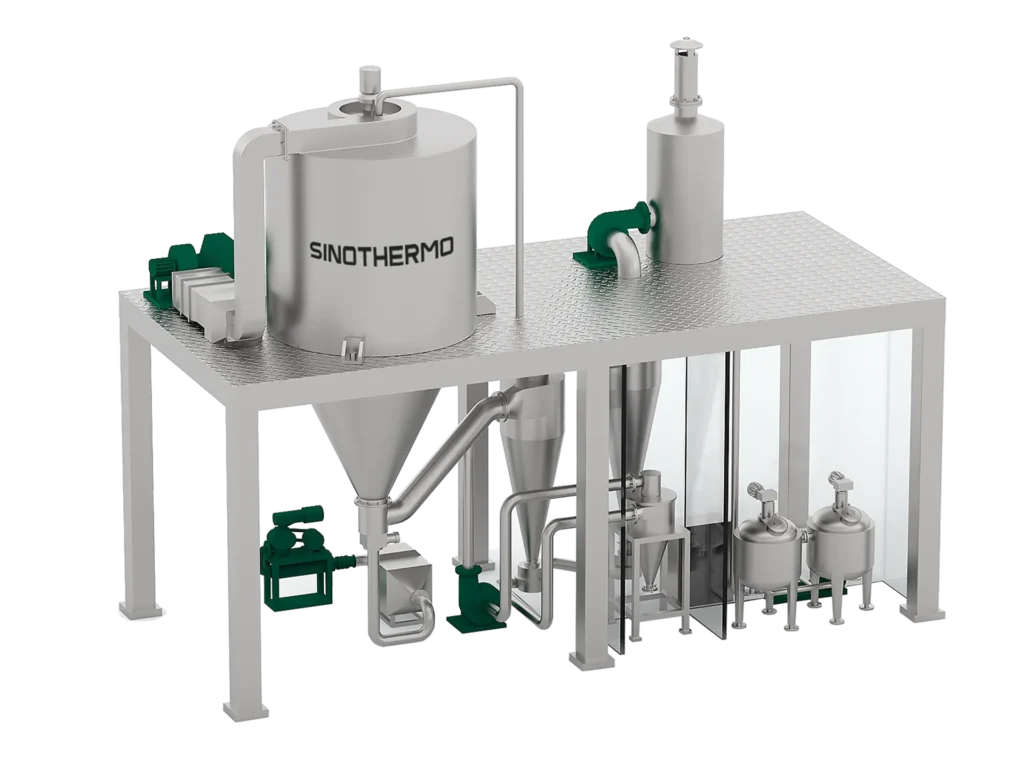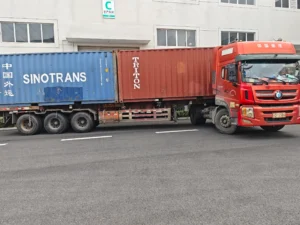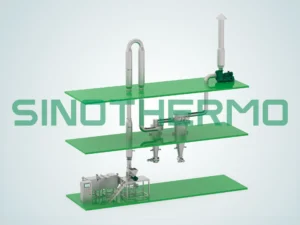Introduction to Drying in Chemical/Pharma Manufacturing
Drying is a critical unit operation in the chemical and pharmaceutical industries, playing a crucial role in the production of a wide range of products. As described by the Encyclopaedia Britannica, the chemical industry encompasses a complex set of processes and operations involved in the manufacture of chemicals and their derivatives. Within this industry, drying is an essential step in removing moisture from materials, ensuring product quality, stability, and safety.
The drying process can be achieved through various methods, each with its own advantages and limitations. Two commonly employed techniques are flash drying and spray drying. Flash dryers utilize convection drying with hot air to rapidly remove moisture from materials, while spray dryers involve spraying the material into a stream of hot air, allowing for contact drying. The selection of the appropriate drying method is determined by factors such as the material’s properties, desired product characteristics, energy efficiency, and operational requirements.
How Flash Dryers Work
Flash dryers operate on the principle of convection drying using hot air. The core working principle, as described on Acmefil.com, “revolves around the simultaneous actions of hot air and mechanical motion.” The moist material is continuously fed into the dryer, where it comes into contact with a stream of hot air, rapidly evaporating the moisture.
According to Allgaier Process Technology, “A Flash Dryer is a drying unit used to rapidly dry moist and sometimes lumpy materials at high temperatures.” The material’s exposure to the hot air is brief but intense, allowing for rapid drying while minimizing heat exposure that could damage heat-sensitive products.
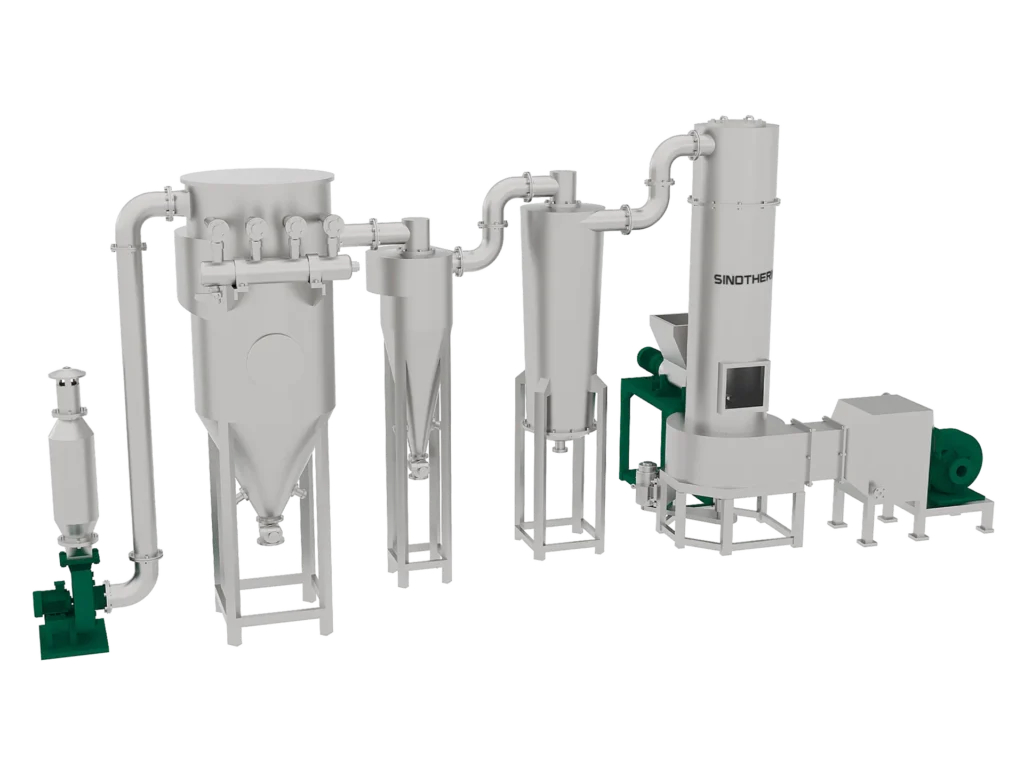
How Spray Dryers Work
Spray dryers operate on the principle of contact drying, where a liquid feedstock is atomized into fine droplets and exposed to a hot air stream. The key steps in the spray drying process are:
- The liquid feed is pumped into an atomizer, which disperses it into a spray of tiny droplets.
- The atomized spray is then contacted with a stream of hot air or gas, causing rapid evaporation of the liquid and formation of dried particles.
- The dried particles are separated from the air stream, typically using a cyclone or bag filter, and collected as a powder.
The atomization stage is critical for creating a large surface area for efficient drying. According to Spray Drying Basics, “The atomization stage is designed to create droplets with a specific size distribution and pattern to optimize the heat and mass transfer rates during the drying stage.”
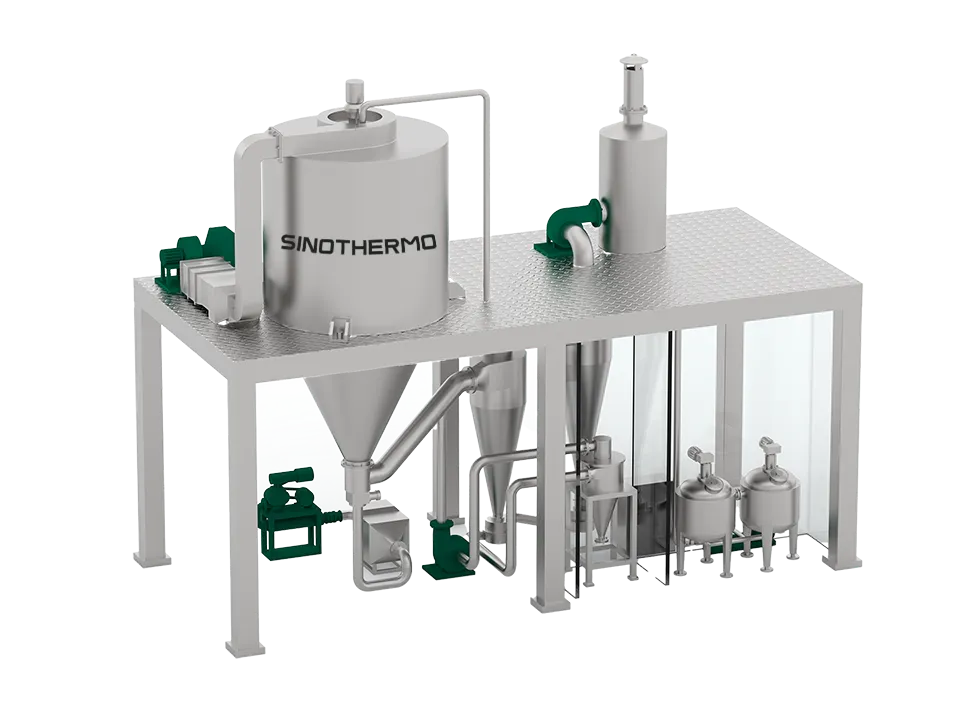
Energy Efficiency Comparison
One key factor to consider when choosing between a flash dryer and a spray dryer is energy efficiency. Flash dryers tend to be more energy-efficient for drying materials with high initial moisture content. According to Engitech, “Flash dryers are faster, more energy-efficient, and require less floor space than traditional drying methods like rotary or spray dryers.” This is because the rapid, convection-based drying process in a flash dryer can remove large amounts of moisture quickly and efficiently.
On the other hand, spray dryers are generally better suited for heat-sensitive materials that require gentler drying conditions. As noted by Hosokawa Micron B.V., “Extensive tests have shown that the DMR continuous flash mill dryer can often replace existing spray drying processes and achieve significant energy savings, especially when dealing with heat-sensitive products.” For materials that can withstand higher temperatures, the flash dryer’s energy efficiency may outweigh the benefits of the spray dryer’s gentler drying process.
Particle Size Control
One of the key differences between flash dryers and spray dryers lies in their ability to control the particle size of the dried product. Flash dryers generally preserve the original particle size of the input material, making them suitable for applications where maintaining the initial particle size distribution is important [1].
On the other hand, spray dryers offer greater flexibility in producing fine powders with a controlled particle size distribution. By adjusting parameters such as the atomization pressure, feed rate, and drying air conditions, spray dryers can create particles ranging from a few micrometers to hundreds of micrometers in size [2]. This ability to produce fine powders is particularly advantageous in pharmaceutical applications, where particle size can influence properties such as dissolution rate, bioavailability, and flowability.
Equipment Footprint
One key difference between flash dryers and spray dryers is their physical footprint or the amount of floor space they require. Flash dryers typically have a smaller footprint compared to spray dryers, making them a more space-efficient option when floor space is limited. As stated in an article from Powder & Bulk Solids, “Given its dispersion as a thin layer, the mechanical flash dryer typically requires a smaller footprint compared to ring and spray dryers.”
In contrast, spray dryers tend to have a larger footprint due to the additional equipment required, such as the atomizer, drying chamber, and cyclone separator. The larger size of spray dryers can be a constraint in facilities with limited available space. If floor space is a major concern, a flash dryer may be the more suitable choice for drying operations.
When to Choose a Flash Dryer
Flash dryers are well-suited for drying high moisture, pumpable materials, making them a common choice in industries like chemical processing and wastewater treatment. According to Dedert Corporation, a leading dryer manufacturer, flash dryers offer several key advantages:
First, they have a relatively small footprint compared to other dryer types, making them ideal when floor space is limited. Flash dryers can also preserve the original particle size of the feed material, an important consideration when dealing with granular or crystalline solids.
For heat-sensitive materials that could degrade at high temperatures, flash drying provides a rapid, low-residence time process. The short drying time minimizes exposure to elevated temperatures. Additionally, flash dryers tend to have lower capital costs compared to spray dryers, reducing the upfront investment required.
When to Choose a Spray Dryer
Spray dryers are the preferred choice when producing very fine powders with tight particle size distribution. Their ability to atomize liquids into a spray of droplets results in extremely small dried particles, often in the range of 10-100 microns. As noted by Spray Dryer, “Spray drying allows for precise control over particle size, resulting in uniform and consistent end products.”
Another key advantage of spray dryers is their ability to handle continuous high throughput drying operations. They can process large volumes of liquid feed material into a dried powder form. This makes them well-suited for industrial-scale production.
Spray dryers offer flexibility in terms of the types of feed materials they can handle. Whether it’s solutions, slurries, or pumpable liquids with dissolved or suspended solids, spray dryers can effectively dry a wide range of feedstocks into powders.
In addition to producing fine powders, spray dryers allow for close control over the particle size distribution of the dried product. Parameters like atomizer design, drying air flow, and residence time can be adjusted to tightly control the final particle size characteristics.
Spray dryers can also accommodate feed materials with higher initial moisture content compared to flash dryers. Their design efficiently removes moisture through contact drying as the liquid spray meets the hot drying air.
Key Material Properties to Evaluate
When selecting between a flash dryer or spray dryer, several key material properties must be carefully evaluated:
Initial Moisture Content: The initial moisture level of the material is a critical factor. Flash dryers are better suited for materials with high initial moisture content (>50%), while spray dryers can handle a wider range but may be less efficient for very high moisture levels (Source).
Desired Particle Size: If preserving the original particle size is important, flash drying is the better choice. Spray drying, on the other hand, excels at producing very fine, uniform powders down to the micron range (Source).
Temperature Sensitivity: For heat-sensitive materials that can degrade at high temperatures, spray drying may be preferred as the short residence time limits exposure to elevated temperatures. Flash drying uses lower temperatures but for longer durations.
Other Operational Factors
Beyond the core technical considerations of energy efficiency and particle size control, several other operational factors should be weighed when selecting between a flash dryer or spray dryer. These include:
Space constraints: Flash dryers typically have a smaller equipment footprint than spray dryers, making them advantageous for facilities with limited floor space. As noted by Kason Corporation, “Flash dryers are compact, requiring a relatively small area for installation.”
Utility costs: The operating costs associated with heating air, as well as any solvent recovery systems, should be evaluated based on anticipated throughput volumes. Spray dryers generally have higher utility expenses due to their continuous operation.
Throughput requirements: For high volume, continuous drying needs, spray dryers are often preferred due to their ability to handle larger feed rates. Conversely, flash dryers may be more suitable for lower throughput or batch operations.
Continuous vs batch processing: Spray dryers are inherently designed for continuous operation, while flash dryers can be configured for either continuous or batch cycles depending on production needs.
Economic Comparison
When evaluating the economics of flash dryers versus spray dryers, it’s important to consider both the upfront capital costs as well as the ongoing operating expenses over the equipment lifetime. In general, flash dryers tend to have lower capital costs compared to spray dryers due to their simpler design and smaller footprint (Source). However, spray dryers can be more energy-efficient for certain applications, which can offset some of the higher initial investment through reduced utility costs.
From an operating cost perspective, spray dryers typically have higher energy requirements since more water needs to be evaporated from the feed material. Flash dryers are generally more efficient when drying materials with high initial moisture content. Labor costs are relatively similar between the two technologies. Ultimately, a detailed total cost of ownership analysis should be performed, taking into account utility rates, throughput requirements, and desired product characteristics (Source).
Testing and Validation
Selecting the right drying equipment is crucial for optimizing operations, and pilot testing is an invaluable tool in this process. As highlighted by De Dietrich Process Systems, pilot testing involves creating a miniature version of the production-scale operation, providing valuable feedback with minimal risk. By working with experienced vendors like Glenro Inc., which has over 60 years of experience in process development and testing, manufacturers can validate the performance of potential drying solutions with their specific materials and operating conditions.
Comprehensive testing and services offered by companies like De Dietrich Process Systems can help evaluate factors such as energy efficiency, particle size distribution, and product quality. This hands-on approach allows for fine-tuning and optimization before committing to a full-scale installation, minimizing risks and ensuring the selected drying technology meets the specific requirements of the application.
Application Examples
Flash dryers are well-suited for drying high moisture, pumpable materials like kaolin clay slurries in the production of fillers and coatings. As noted in the Dryers entry from the University of Michigan, “Flash dryers are also used to produce fine, homogeneous, non-agglomerated powders, such as the kaolin clay shown below.”
Spray dryers are commonly used in the pharmaceutical industry to produce dry powder formulations for inhalation. According to Dedert’s Spray Drying Guide, “Spray drying is a cost-effective solution for producing dry powders from liquid solutions or slurries. It is especially useful for drying heat-sensitive materials like pharmaceuticals, foods, and some industrial products.”
Optimizing Drying Operations
Drying is a critical operation in chemical and pharmaceutical manufacturing processes, with significant impacts on product quality, energy consumption, and overall operational efficiency. Optimizing drying operations is essential for improving process control, reducing costs, and enhancing sustainability.
Manufacturers should collaborate with experienced vendors and engineering firms to evaluate their specific drying needs and select the most appropriate technology. Factors such as material properties, desired particle size, energy efficiency, and footprint constraints should be carefully considered. Pilot testing and validation are crucial steps to ensure the chosen drying solution meets performance requirements.
By working with experts and leveraging advanced technologies like agitated Nutsche filter dryers or Chemical Foam Systems (CFS), manufacturers can optimize drying times, reduce energy consumption, and improve process control. Continuous improvement and adoption of innovative solutions, such as machine learning for predicting resin drying temperatures, can further enhance drying operations and drive operational excellence.
Conclusion
Selecting the right drying technology is critical for optimizing operations in chemical and pharmaceutical manufacturing. Flash dryers and spray dryers each have distinct advantages and are well-suited for different applications.
Flash dryers excel at efficiently drying high moisture, pumpable materials while preserving the original particle size. They are a compact solution with lower capital costs, making them ideal when floor space is limited or for heat-sensitive materials. However, they cannot produce ultra-fine powders.
Spray dryers offer greater flexibility in handling a wide range of feed materials and producing very fine, uniform powders. While they require a larger footprint and higher capital investment, spray dryers enable tighter control over particle size distribution and can handle higher initial moisture contents at higher throughputs.
To select the best drying technology, carefully evaluate your material properties, desired particle characteristics, space constraints, and economic factors. Pilot testing is highly recommended to validate performance and optimize operating parameters before investing in a full-scale system.
Partnering with experienced drying equipment manufacturers or process engineering firms can provide valuable guidance throughout the selection, testing, and implementation process. Their expertise can help ensure you implement the most suitable and efficient drying solution for your specific needs.
Ivey excels in effectively conveying company directives through impactful marketing and public relations strategies, showcasing her expertise in the field.
Email: ivey.tang@sinothermo.com
Phone: +86 19105155639
